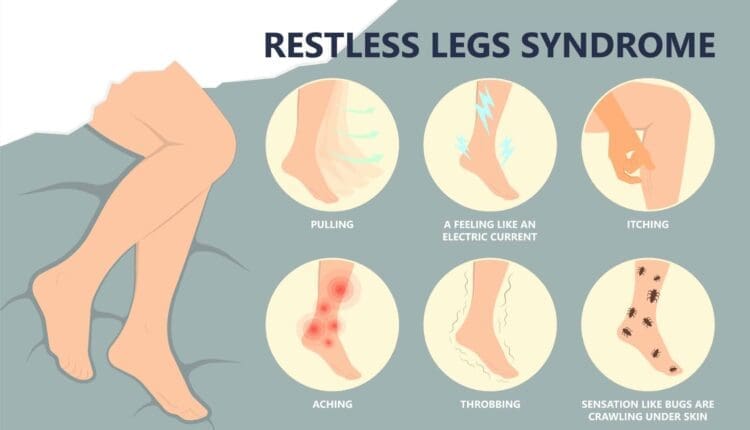Managing Periodic Limb Movements of Sleep for Better Rest
For individuals experiencing periodic limb movements of sleep, can understanding how movements at night may relate to other sleep disorders help bring healthy sleep?

Periodic Limb Movements of Sleep
Periodic limb movements of sleep (PLMS) are involuntary, repetitive leg and sometimes arm movements during sleep. PLMS is one of the sleep disorders that may cause disruptive movement of the legs, like restless legs syndrome (RLS). It can lead to sleep disruption, insomnia, and daytime sleepiness.
Causes
The exact cause of PLMS is unknown, but it is thought to be related to:
- Underlying medical conditions (e.g., restless legs syndrome, sleep apnea)
- Nerve dysfunction
- Neurochemical imbalances (e.g., dopamine, iron)
Symptoms
- Repetitive leg and/or arm movements during sleep, typically lasting 0.5-5 seconds.
- It may be accompanied by sensations of tingling, crawling, or pulling in the legs.
- It can cause sleep disturbances, leading to daytime fatigue.
Type of Movements
Periodic limb movements during sleep (PLMS) consist of sudden jerking movements of the legs that occur involuntarily during sleep, which the affected individual may not realize is happening. It can be kicking, twitching, or extension of the legs.
- Restless legs syndrome (RLS) symptoms are noted when awake.
- PLMS occurs during sleep. (Walters A. S., & Rye D. B. 2009)
- The movements associated often consist of flexion or extension at the ankle.
- In some cases, this can also occur at the knee.
- It may occur on one side or alternate back and forth between the left and right sides. (Cleveland Clinic, 2023)
- It tends to increase with age and often but is not always accompanied by restless leg symptoms.
If PLMS causes daytime impairment, such as significant sleep disruption, excessive daytime sleepiness, and insomnia, it may be diagnosed as periodic limb movement disorder (PLMD). (Sleep Foundation, 2024)
Diagnosis
PLMS is diagnosed through a sleep study (polysomnography), which records brain waves, eye movements, muscle activity, and breathing patterns during sleep. As part of the study, superficial electrodes are placed on the legs and sometimes the arms to detect muscle contractions or movements.
- In individuals with PLMS, repetitive movements at least four in a row may last from 1/2 second to 5 seconds.
- The movements may be more significant if they are associated with arousal or awakenings from sleep.
- They also may be deemed important if they become disruptive to a bed partner.
- No further treatment may be necessary when noted in isolation on a sleep study without associated symptoms or impacts.
- If another disorder cannot explain the movements, PLMS may be the likely diagnosis.
- Again, if the movements lead to sleep disruption, insomnia, and excessive daytime sleepiness, it is called PLMD.
- Isolated PLMS noted on a sleep study, without consequence, are insignificant and do not require treatment with medication.
Restless leg syndrome is diagnosed based on clinical criteria of having an uncomfortable feeling in the legs associated with an urge to move that occurs in the evening when lying down and is relieved by movement. (Stefani, A., & Högl, B. 2019)
Treatment
Treatment for PLMS depends on the underlying cause and severity of symptoms. Options include:
- Medications (e.g., dopamine agonists, iron supplements)
- Lifestyle changes (e.g., exercise, avoiding caffeine before bed)
- Treating the underlying medical condition
In general, it is unnecessary to treat PLMS if the individual affected has no complaints of sleep disruption. Treatment can be considered if it causes:
- Partial or total arousal from sleep
- Contributes to insomnia
- Undermines sleep quality
- Also, if the movements are disruptive to a bed partner, getting them under control may be desirable.
Prescription medications can be effective in treating PLMS. (Cleveland Clinic, 2023) Many of the meds used to treat RLS can be helpful. These may include benzodiazepines (clonazepam), Mirapex (generic name pramipexole), and ropinirole. Movements may also occur with obstructive sleep apnea events, and then the treatment would target the breathing disorder.
Injury Medical Chiropractic and Functional Medicine Clinic
Individuals who struggle with sleep or other sleep disorders that impact their ability to get restful sleep should consult with their healthcare provider about getting an assessment and treatment to restore health. Individuals can recover and regain the benefits of quality rest through healthy sleep practices and lifestyle accommodations. Injury Medical Chiropractic and Functional Medicine Clinic works with primary healthcare providers and specialists to build optimal health and wellness solutions. We focus on what works for you to relieve pain, restore function, prevent injury, and help mitigate issues through adjustments that help the body realign itself. They can also work with other medical professionals to integrate a treatment plan to resolve musculoskeletal problems.
Revitalize and Rebuild with Chiropractic Care
References
Walters, A. S., & Rye, D. B. (2009). Review of the relationship of restless legs syndrome and periodic limb movements in sleep to hypertension, heart disease, and stroke. Sleep, 32(5), 589–597. https://doi.org/10.1093/sleep/32.5.589
Cleveland Clinic. (2023). Periodic limb movement disorder (PLMD). https://my.clevelandclinic.org/health/diseases/14177-periodic-limb-movements-of-sleep-plms
Sleep Foundation. (2024). Periodic Limb Movement Disorder What it is, what it feels like, its possible causes, and how it’s addressed. https://www.sleepfoundation.org/periodic-limb-movement-disorder
Stefani, A., & Högl, B. (2019). Diagnostic Criteria, Differential Diagnosis, and Treatment of Minor Motor Activity and Less Well-Known Movement Disorders of Sleep. Current treatment options in neurology, 21(1), 1. https://doi.org/10.1007/s11940-019-0543-8

